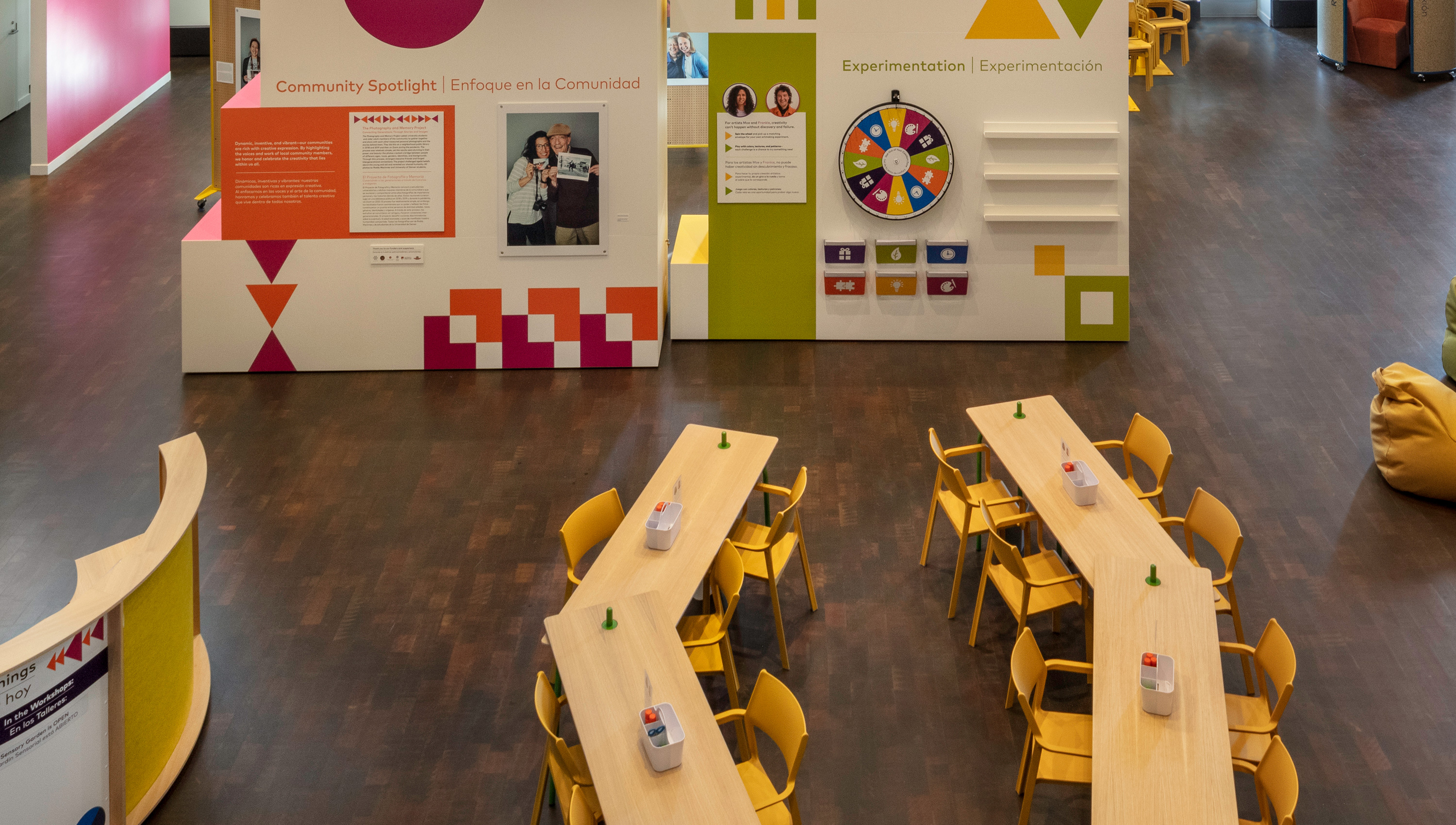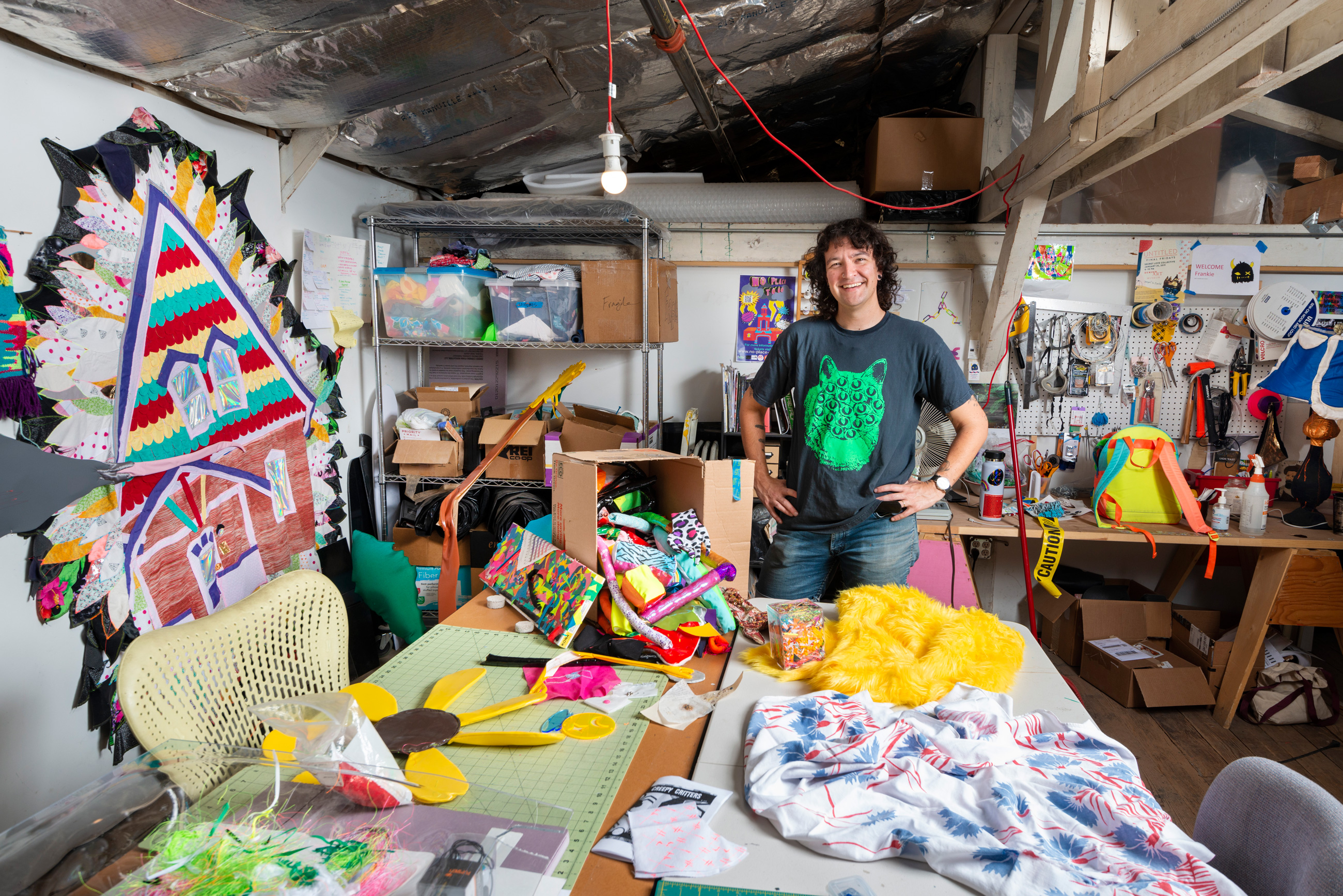Toan: Over the past 2+ years Moe and I have worked with the Learning and Engagement department team on analyzing our creative practices, and the process of making art. We first identified the steps involved in artmaking, which were not as straightforward as acquiring materials, sketching, etc., but involved much more intangible things like experimentation, failure, and reflection. There were many surprising moments throughout our (very fun) conversations. First, I had never really tried to break apart or analyze my process—it was something that was intuitive for me. Talking about it with Moe and the team at the museum helped me to realize that Moe and I engage in the many of the same intuitive steps of experimenting with new ideas, stepping away from a piece for a while, and gathering and meditating on inspiring materials. I loved talking about the process, and seeing the ways that Moe and I work differently and similarly.
Gram: The process for creating activities for the Creative Hub started with a wide variety of meetings. In early meetings, the Learning and Engagement staff asked Frankie and I a lot of questions about out creative process, how we generated work, dealt with failure, experimented, found inspiration, and how reflection showed up in our process. From there we used those notes to generate ideas or brainstorms for possibilities for activities. Conversations would spark new ideas, edits, and/or adjustments until finally, we were able to land on some great activities for patrons and families to participate in. After that we recorded the shred your expectations video, the audio for the reflection pods, had a photo shoot in our studios, and installed work in the glass case.
What did you learn/take away from collaborating with each other and DAM staff?
Gram: I definitely learned that I love and adore Frankie. We met during this process and I have become a big fan of them as a creative, but also as a person. I also really appreciate the DAM staff. It has been such a fun process working with them. They gave me a structure for examining my creative process and that has been super fun. I relearned myself as an artist and that is in many thanks to this crew.
Toan: I loved working on this project. It was so lovely to have the museum staff facilitating our reflection on our own practices. I learned a lot about how I work, what the important steps are while making, and I developed huge admiration for Moe. I love Moe’s process, and talking with her about how she finds inspiration was inspiring for me. It’s hard to not enjoy talking about the creative process. There’s an element of mystery and magic to it, so working to develop activities that could foster that sense of creativity and magic in others was very gratifying. The DAM team had so many good ideas of how to translate something like failure—a hugely important part of my own (and Moe’s it turns out) practice—into the simple idea of “shredding your expectations.” They were able to put words and gestures to the core ideas of making.
How did creating the activities for the Creative Hub help you reflect on your own creative practice? What did you learn as artists? Has anything stuck with you after?
Toan: Breaking down my own creative practice into major and minor steps, and putting words to those steps was nourishing in a lot of ways. I am lucky to be able to spend a large amount of time creating, but I’d also lost sight of the magic that happens—the unexplainable small moments that span the translation of raw material to finished piece. I was thinking about physical steps: buying the fabric, making the pattern, cutting the material, piecing, stitching, turning, stuffing… but the years of trial and error that it took me to learn to make the correct pattern for a stuffed strawberry, or how to even start to think in 3-D shapes… I hadn’t reflected on that wealth of knowledge I had been developing over the years. It was a gift to recognize the depth of my relationship with the materials I use, and the ways in which I am still learning. I don’t know how often artists get to feel like “experts in their field”, and working with the DAM on this project helped me to see my own expertise. I also have a renewed respect for the magic of making, and the process.
Gram: I was able to examine my intention for specific actions in the studio. It is easy to get into a habit of operating without really consulting with myself. I can just "go" and "do" very easily almost like tunnel vision. I get stuck in a loop. This process allowed me to allocate intentional time in the studio to think, reflect, reevaluate, and explore what occurs in my creative practice. Now that the Creative Hub is open, I get to be reminded of all I learned. When I look at my newer works, I can see how much I have evolved since our first meeting about this project in 2019. Many of my creative choices, while still fun and playful, have become so much more calculated. I love this for myself because, as a mostly abstract artist, it is important for me to make sure my work is accessible to people who are able to view it. I now have a better understanding of why I make the choices I make and have more trust in my approach to various projects.
You created an installation together in the Creative Hub–The Perfect Storm. Can you share a little bit about this piece, the process you two went through to create it, and what it was like working together?
Gram: Many of the people who will visit the Creative Hub will be introduced to my work for the first time. I wanted to create a piece that gave a brief snapshot to the history of my creative practice and a sprinkle of where I am now as an artist. Many of the materials in my installation have been collected over the last 5–10 years. For people who are familiar with my work or my career, I wanted them to be reminded of how much they have seen me grow since their first encounter with my work. Frankie is always the easiest person to work with. We are both very aligned in our color choices, material use, subject matter, communication style, and general approach to the creative process. They are organized and consistent, which is 100% my love language. We work very well together with very little effort.
Toan: I could not have wished to work with any artist more wonderful and inspiring than Moe on this project. We got to know each other much more deeply while working with the DAM. We both work with themes of community and connection, and we both use similar color pallets. We have now collaborated a few times, and working with Moe feels natural and dynamic. She and I make similar aesthetic choices, but she will ask questions or bring up ideas that I never would have thought of. Making The Perfect Storm was very easy and our work flows seamlessly together. We are two creative peas in a pod and I will always look forward to working with Moe.




